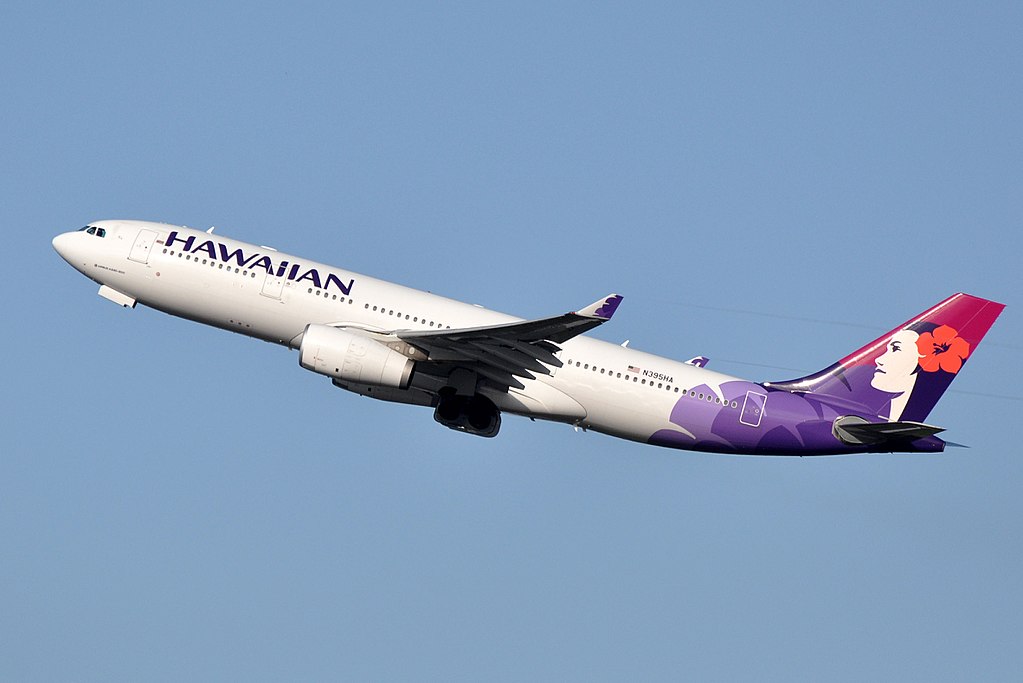Hawaiian Airlines Having One Hot Summer as Mainland Demand Beats 2019

Photo Credit: Favorable lease rates on its Airbus A330s will allow the airline to open new markets next year. Wikimedia / Eric Salard
Hawaiian Airlines is enjoying someting of a "hot vaxxed summer" as it seeks to fulfill an almost insatiable demand for vacations in its home state. The carrier now is flying more routes and passengers between the U.S. mainland and the archipelago than it did before he pandemic began, and the company expects this only to increase as the state eases some of the country's strictest travel restrictions.
Its mainland expansion offsets the near-total collapse of its international network. Before the pandemic, Hawaiian's route structure depended on three discrete networks: U.S. mainland-Hawaii; inter-island travel; and international flights from Asia and Australia and New Zealand to Hawaii. Hawaiian does not expect to resume its Australia and New Zealand flights this year. Its flights to Japan and South Korea remain idled, although CEO Peter Ingram said as vaccination rates progress in those two countries, demand could start to return by the fourth quarter. "There's a voracious appetite to travel to Hawaii from Japan," he told analysts during the company's second-quarter earnings call on Tuesday. Although Hawaiian added back one flight to South Korea and restarted service to Tahiti, in all it operated just 11 percent of its pre-pandemic international routes this year.
Meanwhile, routes to the U.S. mainland have seen torrid growth, with traffic now exceeding pre-pandemic levels despite more competition on the routes. Because many U.S. carriers have added flights to Hawaii, there is now between 125-128 percent more capacity on routes to the U.S. mainland now than there was in the third quarter of 2019. Hawaiian added Honolulu-Austin and Maui-Phoenix flights in the quarter, in addition to the Orlando flights it announced earlier this year.
During the quarter, Hawaii relaxed its quarantine and testing requirements for vaccinated travelers to enter the state as well as relaxing some of its restrictions on inter-island travel. The state will drop all restrictions when 70 percent of the population is vaccinated. About 60 percent is fully vaccinated now, according to the state's health department.
Ingram expects that when the state crosses that milestone, demand will increase. The booking curve is lengthening out to pre-pandemic levels in anticipation, and bookings for the year-end holiday period already appear strong, he said, adding, "It's a real 180 from where we were early this year."
The carrier, however, is unlikely to add more cities to its U.S. mainland map, although itmay add additional frequencies to existing cities. Hawaiian expects its international network to start recovering by the end of the year, and therefore will need to return its widebody aircraft to those routes. "We need to balance the desire to chase more revenue now versus future network needs," Ingram said.
One new trend Hawaiian has noticed since travel to the archipelago picked up is increased demand for premium seats. Vacationers seem more willing to pay for a seat in the front of the aircraft than they were before the pandemic. This trend shows no sign of abating, either, Ingram said.
The third leg of Hawaiian's network, inter-island flying, also is recovering now that the state has eased quarantine requirements. Hawaiian is operating 75 percent of its pre-pandemic inter-island network in June. Hawaiian expects to operate about 77 percent of its pre-pandemic inter-island capacity in the third quarter.
The carrier remains committed to its Boeing 717 aircraft for inter-island routes and is not jumping on the electric air taxi bandwagon as other airlines — United and American, for example — have. Although the inter-island network is within the range of the proposed eVTOL aircraft, Ingram said the prototypes, which seat between four and six passengers, are too small to be viable for Hawaiian. "It may be a generation or two before we get there," he said, adding that it most likely will be by the "mid-2030s" before there is feasible electric 717 replacement.
Hawaiian also remains committed to its Boeing 787-9 order and has no plans to cancel the 10 it has on firm order, despite having deferred its first deliveries until next year. Ingram dismissed the idea that the carrier would fall back on its existing fleet of Airbus A330s for international expansion. "The Boeing 787 ... is destined to be the flagship of our fleet," he said. "We are still very excited to get it."
Hawaiian also is planning to resume hiring, especially for ground and airport positions. It is training pilots and cabin crew in anticipation of the resumption of international demand. If those routes don't recover by the end of the year, Hawaiian may have a labor surplus, but it has no plans to trim its roster further.
Despite the optimism, Hawaiian continued losing money. In the second quarter, the carrier reported an adjusted loss of $74 million on revenues of $411 million, down 42 percent from the same quarter in 2019. This generated an operating margin of -23 percent. The carrier operated 30 percent fewer available seat-miles than it did in the same period in 2019. Hawaiian benefited from $204 million in federal payroll support and loans in the quarter.
For the third quarter, Hawaiian projects capacity to be down between 20-23 percent, and revenues to be down 28-33 percent compared with the the third quarter of 2019.
